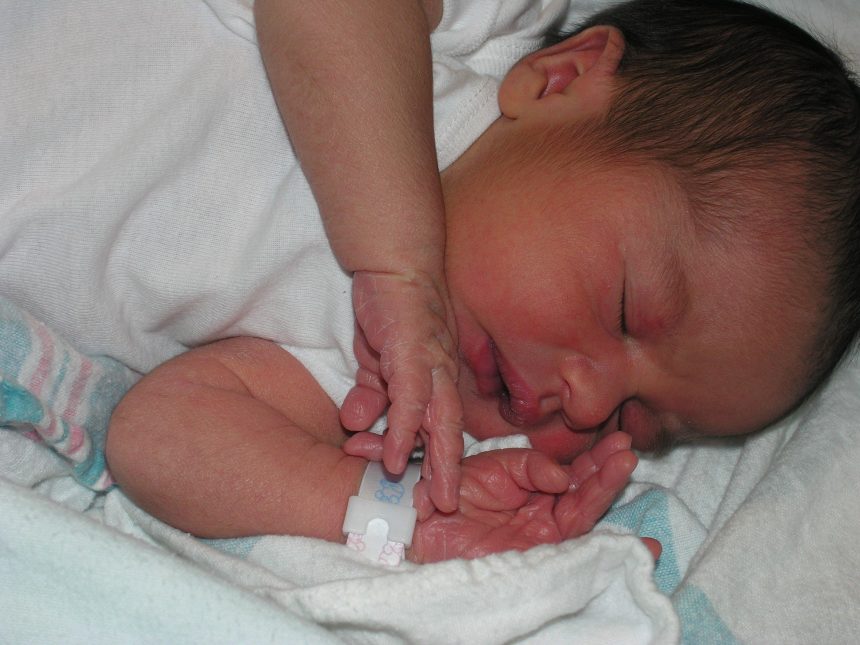Title: Newborn Won’t Sleep in Bassinet at Night: How to Help Them Adjust
Introduction:
The transition to parenthood is often marked by sleepless nights, particularly in the early weeks following the birth of a child. Among the myriad challenges faced by new parents, one of the most pressing concerns is a newborn’s reluctance to sleep in a bassinet at night. This phenomenon is not merely a matter of inconvenience; it can have significant implications for the well-being of both the infant and the caregivers. Understanding the factors that contribute to a newborn’s sleep patterns is essential for developing effective strategies to foster healthy sleep habits. Recent research highlights the importance of environmental, physiological, and psychological elements that influence infant sleep behaviors. This article will explore the underlying causes of nighttime unrest in newborns, offering evidence-based recommendations to help parents facilitate their child’s adjustment to sleeping independently in a bassinet. By addressing these challenges comprehensively, we aim to equip caregivers with the tools necessary for nurturing a more peaceful and restorative sleep environment for both themselves and their infants.
Understanding the Reasons Behind Newborn Sleep Resistance in Bassinets
The transition to sleeping in a bassinet can be challenging for many newborns, often stemming from instinctual behaviors and environmental factors. One significant reason for sleep resistance is the startle reflex, also known as the Moro reflex, which can spark an innate sense of alertness in infants. This reflex causes sudden jerking movements, potentially waking them up when they feel the change from being held close to lying in an open bassinet. Additionally, the bassinet’s different texture and lack of parental warmth compared to being held may create feelings of insecurity, prompting the infant to resist settling down.
Environmental influences may also play a vital role in a newborn’s reluctance to sleep in a bassinet. Factors such as ambient noise, temperature, and lighting can disrupt an infant’s ability to fall asleep. For instance, if the room is too bright or noisy, the infant may struggle to enter deeper sleep stages. An inconsistency in their sleep environment can lead to confusion and discomfort. To address these concerns, caregivers can consider implementing a consistent sleep routine, optimizing the sleeping environment, and using soothing sounds or white noise to create a more conducive atmosphere for sleep, potentially aiding in their adjustment to the bassinet.
Strategies for Creating a Sleep-Conducive Environment for Newborns
Creating an environment that encourages restful sleep for your newborn is essential for both their well-being and yours. First and foremost, consider the lighting of the nursery. Soft, dim lighting can help signal to your baby that it is time for sleep. Implementing blackout curtains can also minimize external light disruptions, allowing your child to sleep longer and more soundly. Additionally, maintaining a consistent temperature in the room is important; aim for a comfortable range of 68-72°F (20-22°C) to ensure your baby is neither too hot nor too cold. Other elements to consider include white noise machines, which can effectively drown out sudden noises that might startle your baby awake.
Furthermore, the layout of the sleeping area can greatly influence your newborn’s sleep patterns. Position the bassinet in a quiet corner away from windows and doors to minimize distractions. The use of a firm mattress with a fitted sheet is crucial; it not only adheres to safe sleep guidelines but also provides the right level of support. Consider a safe sleep space that includes the following:
| Element | Description |
|---|---|
| Firm Mattress | Supports safe sleep practices. |
| Fitted Sheet | Fits snugly, reducing risk of suffocation. |
| Swaddle | Provides comfort and security. |
| Breathable Fabrics | Promotes airflow and temperature regulation. |
Incorporating these strategies will not only assist in creating a more sleep-friendly atmosphere for your newborn but will also aid in their adjustment to sleeping in the bassinet at night. By carefully curating their environment, you can foster a sense of security and calm that may help ease the transition for both you and your baby.
Establishing a Consistent Nighttime Routine to Promote Sleep
Creating a reliable nighttime routine plays a crucial role in helping your newborn transition to sleeping in their bassinet. A *consistency-focused approach* fosters an environment where your baby can feel secure and relaxed, which in turn encourages restful sleep. The following practices can be beneficial:
- Dim the lights: Gradually reduce brightness in your baby’s room to signal that it’s time to wind down.
- Establish a calming environment: Use white noise or soft lullabies to create a soothing backdrop.
- Engage in gentle activities: Activities such as a warm bath or a gentle massage can help your newborn relax.
- Follow a consistent schedule: Aim to start the bedtime routine at the same time every night to help your baby recognize a pattern.
Additionally, it is important to pay attention to your newborn’s cues. Understanding their natural rhythms can guide you in tailoring the routine to better meet their needs. To aid this process, consider tracking their sleep patterns over a week. The following table outlines a simple approach to monitor sleep cues:
| Day | Awake Time | Fussiness Level | Sleep Duration |
|---|---|---|---|
| Monday | 1-2 hours | Moderate | 4 hours |
| Tuesday | 1 hour | High | 3 hours |
| Wednesday | 1-2 hours | Low | 5 hours |
Using this data, you can refine your approach, reinforcing activities that coincide with longer sleep durations and calmer behavior. By establishing this structure, you not only help your newborn adjust but also lay the foundation for better sleep habits that can persist as they grow.
Consulting Pediatric Expertise for Persistent Sleep Challenges
When a newborn consistently struggles to sleep in their bassinet at night, enlisting the aid of a pediatric expert can provide crucial insights into the nuances of infant sleep patterns. Pediatricians can assess whether the challenges stem from common issues such as hunger, discomfort, or developmental milestones. They can also offer guidance on establishing a soothing bedtime routine that might integrate practices such as:
- Swaddling: Ensures a feeling of security for the baby.
- White noise machines: Mimics the womb environment, calming the infant.
- Dim lighting: Signals to the baby that it’s time to sleep.
Furthermore, if the sleep issues persist, a pediatric sleep specialist may recommend a tailored sleep training program, taking into account the unique temperament and needs of the baby. Research suggests that consistent sleep schedules can significantly improve sleep quality both for the infant and the parents. Below is a simple table outlining potential strategies and their expected outcomes:
| Strategy | Expected Outcome |
|---|---|
| Gradual Sleep Training | Increased self-soothing abilities |
| Consistent Bedtime Routine | Improved sleep onset |
| Regular Feeding Schedule | Reduced night awakenings |
Q&A
Q&A: Newborn Won’t Sleep in Bassinet at Night: How to Help Them Adjust
Q1: What are the common reasons newborns struggle to sleep in a bassinet at night?
A1: Newborns often experience difficulties sleeping in a bassinet due to a variety of factors. These can include the transition from the womb to an external environment, which can feel stark and unsettling. The bassinet may lack the warmth, security, and constant motion babies experience while in utero. Additionally, newborns have irregular sleep patterns and may be more accustomed to being held or swaddled, which can lead to resistance when placed in a bassinet. Environmental factors such as noise, lighting, and the overall comfort of the sleeping space also play significant roles in influencing a newborn’s sleep behavior.
Q2: What strategies can parents employ to help their newborn adjust to sleeping in a bassinet?
A2: Several strategies can aid in the adjustment process. Consistency is key; establishing a routine that mimics the womb environment can be beneficial. Techniques such as gentle rocking, swaddling, and white noise can create a calming atmosphere for the infant. It is also advisable to ensure that the bassinet is placed in a quiet, dimly lit space, reducing environmental stimuli that could disturb the baby. Furthermore, gradually introducing the bassinet during naps while keeping the infant close can help them associate it with safety and comfort.
Q3: Is it advisable for parents to co-sleep with their newborn if the baby refuses the bassinet?
A3: While co-sleeping may provide immediate comfort to both parent and child, it is important to consider the safety recommendations surrounding this practice. The American Academy of Pediatrics advises against co-sleeping due to risks associated with suffocation, strangulation, and sudden infant death syndrome (SIDS). If parents opt for co-sleeping as a temporary solution, it is critical to follow safety guidelines, such as ensuring a firm mattress, eliminating soft bedding, and positioning the baby on their back. Ultimately, parents must weigh the benefits of co-sleeping against potential safety risks and consider transitioning back to the bassinet as soon as feasible.
Q4: How long can parents expect the adjustment period to take?
A4: The adjustment period can vary significantly among infants, typically ranging from a few days to a few weeks. Factors such as the baby’s temperament, medical conditions, and the consistency of the parents’ approach play integral roles in this timeline. It is essential for parents to remain patient and persistent during this period, as newborns are continually adapting to their external environment. Consistent routines and practices, coupled with responsiveness to the baby’s needs, can facilitate a smoother transition over time.
Q5: When should parents seek professional assistance regarding their newborn’s sleep issues?
A5: Parents should consider seeking professional assistance if their newborn exhibits prolonged sleep disruptions, particularly if the baby is consistently inconsolable or demonstrates signs of distress that persist despite attempts at various interventions. Additionally, consulting a pediatrician is advisable if the newborn experiences drastic changes in feeding patterns, shows extreme fatigue, or exhibits unusual behaviors during sleep. Professionals can provide tailored guidance and explore any underlying health conditions that may be affecting the baby’s sleep habits.
Q6: What resources are available for parents seeking further information on this topic?
A6: Numerous resources are available for parents seeking further information on newborn sleep issues. Books from pediatric sleep specialists, online parenting forums, and resources from established organizations like the American Academy of Pediatrics offer insights into sleep patterns and safe sleep practices. Additionally, workshops and parenting classes often address sleep training techniques and strategies for managing newborn sleep challenges. Engaging with healthcare providers for personalized advice can also be invaluable in understanding and addressing individual circumstances.
Final Thoughts
addressing the challenge of a newborn who resists sleeping in a bassinet at night requires a multifaceted approach that encompasses both environmental adjustments and behavioral strategies. Understanding the developmental stages of infants, alongside the importance of establishing a consistent sleep routine, can pave the way for a smoother transition to independent sleep. Parents and caregivers are encouraged to cultivate an atmosphere of comfort and security, while also considering factors such as the newborn’s feeding patterns and sleep cycles. By employing these strategies and remaining patient, caregivers can foster more conducive sleep habits, ultimately benefiting the entire family’s well-being. As we continue to explore the intricate dynamics of infant sleep, it is essential to recognize that each child is unique, and what works for one may not work for another. Continued research and observance will aid in refining our approaches, ensuring that we support our youngest populations in achieving restful sleep.


